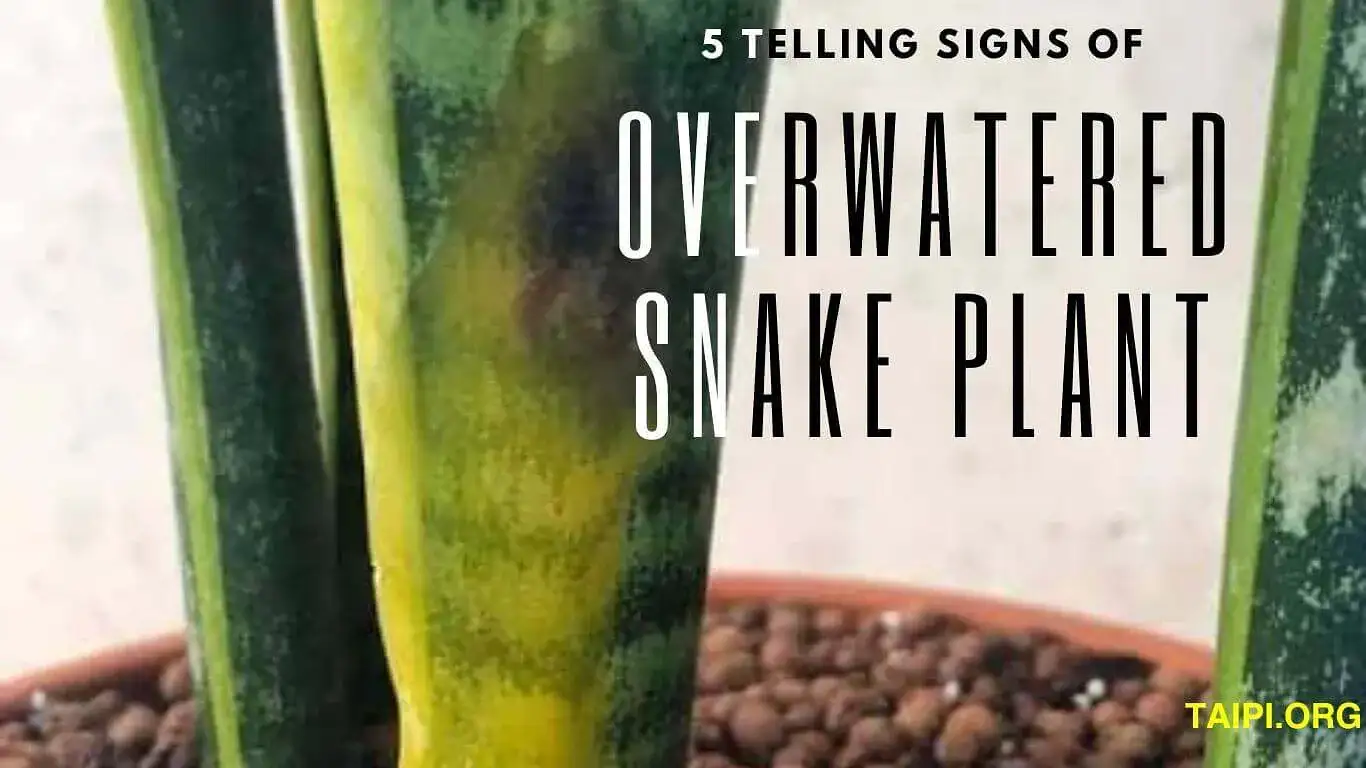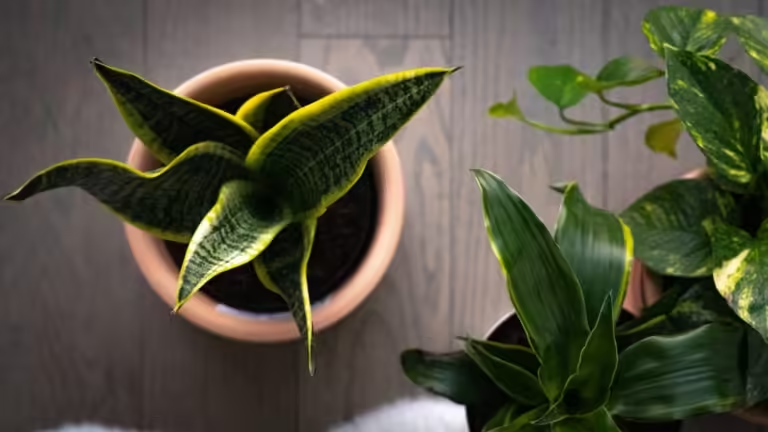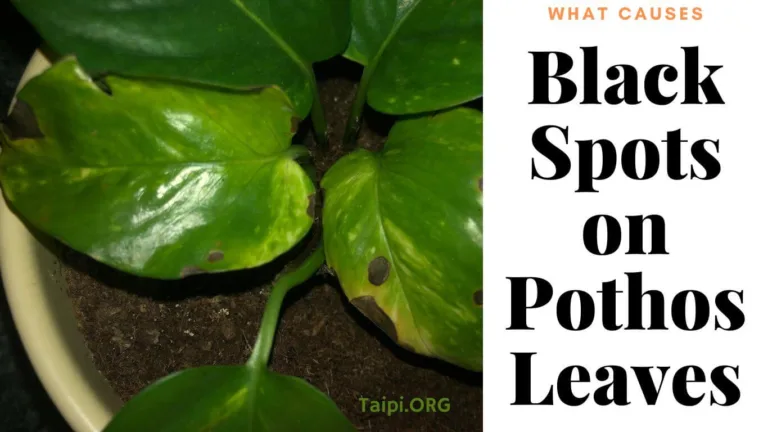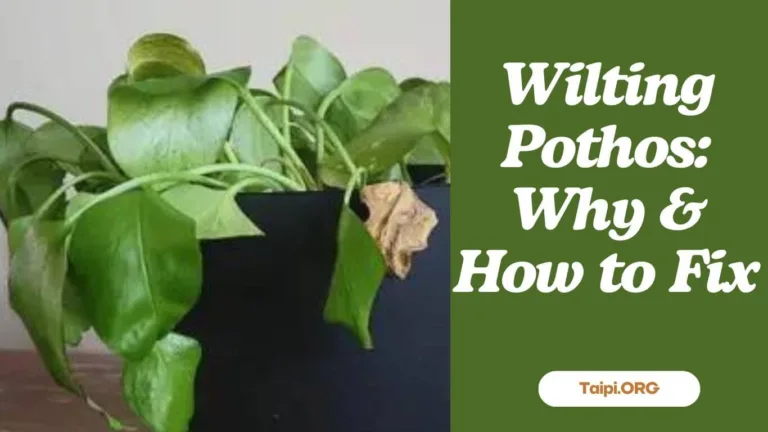Overwatered Snake Plant: 5 Telling Signs & How to Save the Plant
SNAKE PLANTS (Sansevieria) are popular indoor plants thanks to their striking upright leaves and low-maintenance nature. While they are known for their resilience, these hardy plants can suffer from overwatering. Identifying the signs of an overwatered snake plant and taking corrective measures promptly is crucial for the health of your snake plant.
An overwatered snake plant may exhibit symptoms such as drooping, yellowing of leaves, and a tendency to easily fall over. To rescue the snake plant from potential demise, carefully take it out of its container, trim away any decaying roots, and replant it using a new potting mix. Position the plant in an area with bright, indirect light for optimal recovery.
5 Telling Signs of An Overwatered Snake Plant
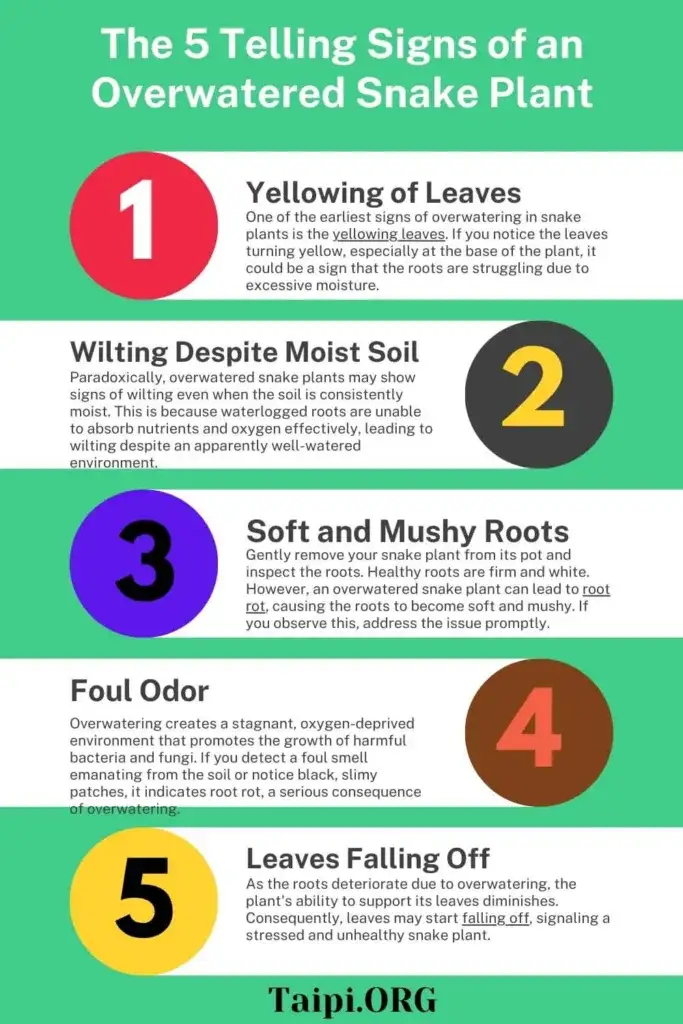
Now, here are the five vindictive signs of an overwatered snake plant:
1. Yellowing of Leaves
One of the earliest signs of overwatering in snake plants is the yellowing leaves. If you notice the leaves turning yellow, especially at the base of the plant, it could be a sign that the roots are struggling due to excessive moisture.
2. Soft and Mushy Roots
Gently remove your snake plant from its pot and inspect the roots. Healthy roots are firm and white. However, an overwatered snake plant can lead to root rot, causing the roots to become soft and mushy. If you observe this, address the issue promptly.
3. Wilting Despite Moist Soil
Paradoxically, overwatered snake plants may show signs of wilting even when the soil is consistently moist. This is because waterlogged roots are unable to absorb nutrients and oxygen effectively, leading to wilting despite an apparently well-watered environment.
4. Foul Odor
Overwatering creates a stagnant, oxygen-deprived environment that promotes the growth of harmful bacteria and fungi. If you detect a foul smell emanating from the soil or notice black, slimy patches, it indicates root rot, a serious consequence of overwatering.
5. Leaves Falling Off
As the roots deteriorate due to overwatering, the plant’s ability to support its leaves diminishes. Consequently, leaves may start falling off, signaling a stressed and unhealthy snake plant.
How to Save an Overwatered Snake Plant
If you’ve accidentally drowned your snake plant in kindness, don’t worry—there’s hope for recovery.
Here are the steps to save an overwatered snake plant and nurse it back to health.
Remove Excess Water
If the soil is waterlogged, quickly remove the excess water. Tilt the pot to allow water to drain out, or use a siphon to extract water from the soil. Ensure proper drainage in the pot to prevent water accumulation in the future.
Assess Root Damage
Gently remove the snake plant from its pot and inspect the roots. If the roots are mushy and discolored, trim away any damaged roots using clean, sharp scissors or pruning shears.
Repot the Overwatered Snake Plant
Choose a well-draining potting mix specifically designed for cacti or succulents. Repot the snake plant into a new container with adequate drainage holes.
Pro tip: Use a pot that is only slightly larger than the plant’s root ball.
Maintain Optimal Watering Routine
Establish a proper watering routine for your snake plant. Allow the soil to dry out completely between watering sessions. While it is advisable to water the plant thoroughly, ensure excess water escapes through drainage holes.
Provide Adequate Light
Snake plants thrive in indirect light, but they can adapt to various lighting conditions. Place your rehabilitated snake plant in a location with bright, indirect sunlight to support its recovery.
Monitor and Adjust
Keep a close eye on your snake plant’s progress. If new growth appears healthy, you’re on the right track. Adjust the watering frequency based on environmental conditions and the plant’s needs.
Consider Root Rot Treatments

If root rot is severe, you may need to treat the remaining healthy roots with a fungicide such as Pure Neem Oil Bliss (pictured above). Follow the product instructions carefully and continue monitoring the plant for any signs of improvement.
Increase Air Circulation
Improve air circulation around the plant by spacing it away from other plants and ensuring proper ventilation in the room. This helps prevent the development of fungal issues.
Pro Tips to Fix Overwatered Snake Plant
Fixing an overwatered snake plant requires a thoughtful approach to address both the symptoms and the root causes of excess moisture. Here are some pro tips to help you revive your overwatered snake plant effectively:
Swift Action is Key
As soon as you notice signs of overwatering, act. The longer the plant remains in waterlogged conditions, the greater the risk of irreversible damage to the roots.
Check the Roots Thoroughly
During the assessment of the roots, not only trim away the visibly affected parts but also check for any hidden or hard-to-see areas of root rot. Removing all compromised roots is crucial for the plant’s recovery.
Use a Well-Draining Soil Mix
Use a high-quality, well-draining soil mix, especially that designed for houseplants. Because aeration is key to preventing waterlogged conditions that can lead to root rot, add some perlites or sand to improve drainage.
Choose the Right Pot

Select a pot with drainage holes (pictured above) to allow excess water to escape. The pot size should be appropriate for the plant’s size, promoting healthy root development without excessive water retention.
Related: Best Pot for Aloe Vera Plant
Attempt Propagation
If the root damage is extensive, consider propagating healthy leaf cuttings. This involves cutting healthy leaves into sections and allowing them to root in a new pot. While not always necessary, it can be a successful way to save the plant.
Have Patience During the Drying Period
Allow the plant and its roots to air dry for an adequate period. This step is critical to prevent the spread of any remaining moisture and to allow the plant to recover before repotting.
Introduce Rooting Hormone (Optional)
To stimulate root growth and enhance recovery, you may try a rooting hormone when repotting. This can encourage the development of new, healthy roots.
Monitor Light Conditions
Provide your snake plant with sufficient bright, indirect light. Adequate light promotes photosynthesis and overall plant health.
However, avoid placing it in direct sunlight for extended periods, as this can stress the recovering plant.
Adjust Watering Habits
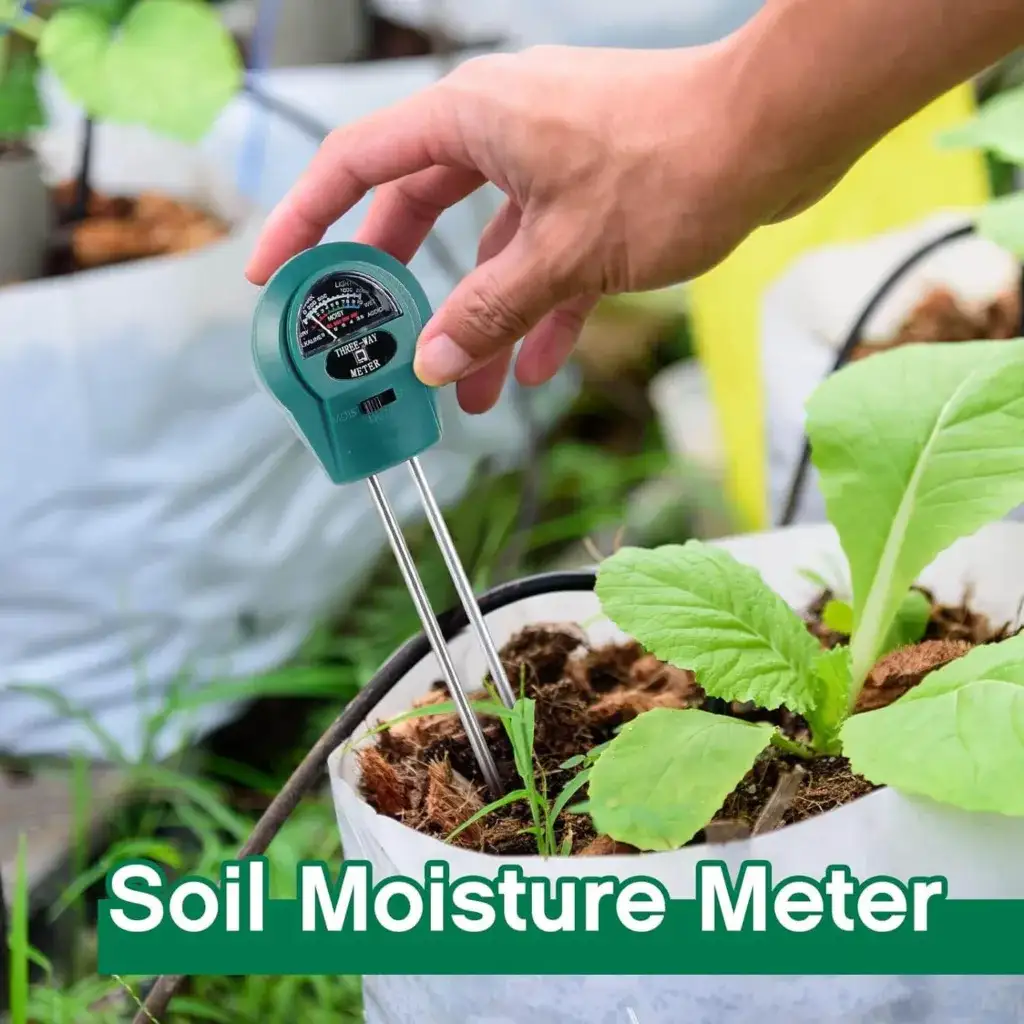
Be vigilant about your watering routine. Allow the soil to dry out between waterings, and adjust the frequency based on the plant’s needs. You can use a moisture meter (pictured above) to accurately gauge soil moisture levels.
Remove Affected Leaves from an Overwatered Snake Plant (If Necessary)
If some leaves are severely damaged, it’s okay to trim them away using clean, sharp scissors or pruning shears. This not only improves the plant’s appearance but also redirects energy toward healthy growth.
Keep Humidity at Bay
Ensure the plant is not exposed to excessively humid conditions. Proper humidity levels prevent the development of fungal issues that may exacerbate the effects of overwatering.
Refrain from Fertilizing Initially
Hold off on fertilizing the plant immediately after repotting. Allow it some time to recover before reintroducing nutrients. Gradually resume a diluted fertilization schedule once the plant shows signs of improvement.
By combining these pro tips, you can increase the chances of successfully fixing an overwatered snake plant and promoting its recovery.
Overwatered Snake Plant FAQs
Q: How can I tell if my snake plant is overwatered?
A: Signs of overwatering in snake plants include yellowing leaves, soft and mushy roots, wilting despite moist soil, a foul odor emanating from the soil, and leaves falling off. If you notice any of these symptoms, it’s an indication that your snake plant may be receiving too much water.
Q: What should I do if I’ve overwatered my snake plant?
A: If you’ve overwatered your snake plant, the first step is to assess the root health. Gently remove the plant from its pot, trim away any mushy roots, and allow the plant and roots to air dry for at least 24 hours. Repot the plant in well-draining soil, adjust your watering routine to let the soil dry out between waterings, and provide adequate light and air circulation. Monitoring the plant’s recovery and adjusting care as needed is crucial.
Q: Can an overwatered snake plant be saved, or is it too late?
A: In many cases, an overwatered snake plant can be saved with prompt and appropriate action. Trimming away affected roots, repotting in well-draining soil, adjusting the watering routine, and providing the right environmental conditions can often lead to recovery.
However, the extent of damage and the plant’s overall health will influence the success of revival. It’s essential to be patient and monitor the plant’s progress as it adjusts to its new, healthier conditions.
My Final Thoughts on How to Salvage an Overwatered Snake Plant
Caring for a snake plant involves finding the right balance, especially when it comes to watering.
Recognizing the signs of an overwatered snake plant and taking corrective action promptly can save your snake plant from severe damage.
With proper care, your snake plant can bounce back to health, gracing your living space with its unique beauty once again.
Remember, consistent care and patience are crucial elements in nursing your plant back to health.

